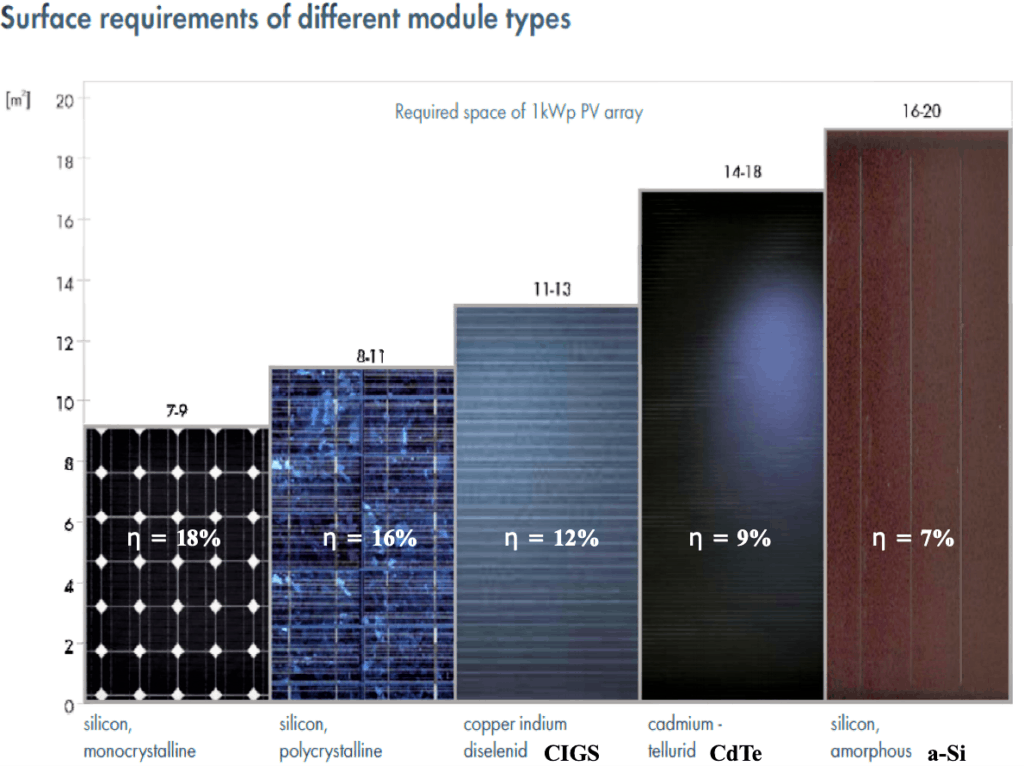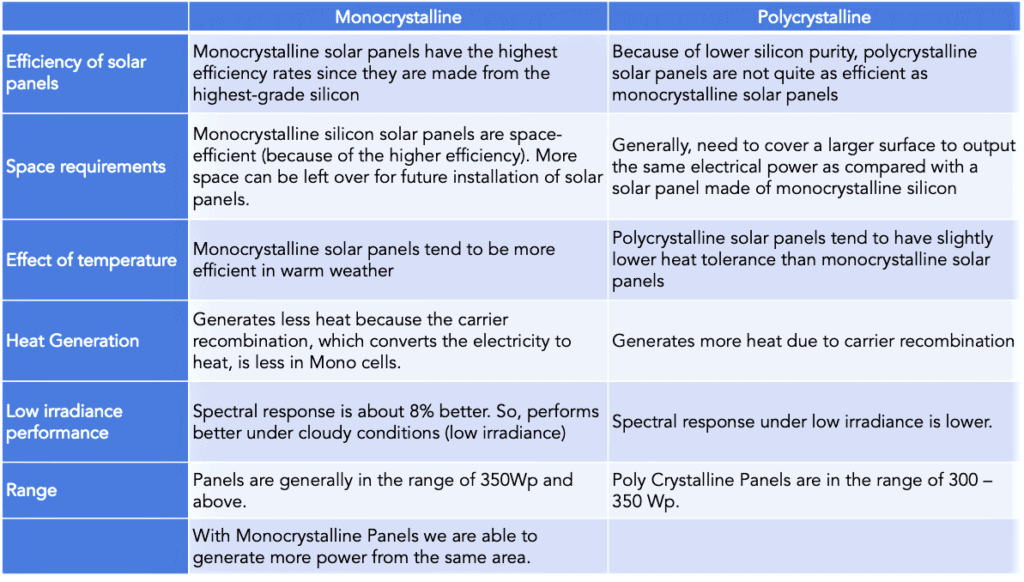With the advancement in solar power technology and the government’s thrust on renewable energy, more and more people are starting to invest in solar power systems. Utilising the rooftop to instal solar panels to generate electricity
However, there are many things to consider before the installation process. Understanding different factors such as technology, policy, permissions, etc involved in a project like this are important.
Here are frequently asked questions on rooftop solar installation in Bengaluru:
Technology
How much space is required for installing rooftop solar?
A typical 1 kWp (kilowatts peak) of solar system consisting of 3 panels needs roughly 70 Sqft or 7 sqm of shade free area.

In Bengaluru, a typical 1 kWp of solar system generates around 4 units of energy on average per day, throughout the year.
What is the best position/direction for installing solar panels?
Solar modules have to face the sun at all times of the year in order to maximize energy yield. Hence modules face the south in the northern hemisphere and towards the north in the southern hemisphere. For Bengaluru, optimum generation is with panes facing south and inclined at about 13 degrees. Panels at a higher inclination will generate less solar energy.
How safe are elevated panels?
The elevated structures are made to withstand 140 kmph winds, since Bengaluru is not a coastal area to experience speeds greater than that.
Read more: Guide to installing a rooftop solar plant in your apartment
Are the elevated panels expensive to build?
Creating an elevated structure will add to your project cost, as structural evaluation and the cost of the structure itself will have to be factored in.
What is the maximum capacity of solar power that can be generated in an apartment complex?
Any rooftop on a permanent structure can install a solar plant up to 100% of the sanctioned electrical load of the building. The maximum allowed capacity per meter is 50 Kwp.
Are micro-inverters a good option?
Micro-inverters are more expensive than string inverters. But if cost is not a concern, micro-inverters are a good option as they
- Use the latest technology
- DC to AC conversion happens at each panel level. No separate inverter needed
- If one micro-inverter fails, the rest of the panels continue to generate power
- No DC cabling needed, hence safety is higher
What are the different types of Solar Panels available?
There are two types of solar panels available: Monocrystalline and Polycrystalline solar panels.

Policy
What is the difference between Net Metering & Gross Metering?
Net Metering: Excess power generated can be exported to the grid. If the Export is greater than Import, BESCOM pays for the net export. If the Export is lesser than Import, net import shall be paid by the customer.
Gross Metering: All the energy generated from solar is exported to grid. BESCOM pays a lower fare for every unit exported, Energy consumed will be billed as usual rates.
So, why do they have a gross-metering option at all, considering that it is not economically viable for the solar rooftop apartment (the investor)?
Gross metering option is profitable for the service provider (BESCOM) and not necessarily to the end consumers.
Does gross metering or net metering policy affect the cost of installation?
Installation costs remain the same whether it is gross metering or net metering.
What are the processes for Rooftop Solar?
Solar Systems needs to be approved by the Government of Karnataka through KERC and BESCOM guidelines and rules for interfacing with the grid, under rooftop grid-tied systems :
- Two types of metering options as per prevailing rules of BESCOM
- Grid-connected systems, without batteries.
Will we get power during a BESCOM outage?
The solar grid-connected system works ONLY when the BESCOM grid is available and not during power cuts. During power cuts, for safety reasons, the solar plant goes into Sleep Mode and when Grid supply is back, it again synchronizes with the grid and starts working automatically.
Can we connect our DG set to Rooftop Solar?
DG Sync if done, is to be with the approval of BESCOM and generally not allowed unless protections are in place and generally in manual changeover mode, with reverse protections relays in place. Drawing approvals are also required from BESCOM if this is required.
Is BESCOM approval required even if you do not wish to use the grid?
BESCOM approval is not needed if you are going with an off-grid system for captive consumption.
Power Purchase Agreement (PPA):
Is partial implementation, which can be scaled up over time allowed?
Yes, PPA is signed per meter. If you have 5 meters, you can sign a PPA for 1 meter and later on increase capacity by signing PPA for other meters. However, this option will be subject to the solar rooftop regulations in effect at that time.
If anyone wishes to increase the capacity of the meter for which a PPA is signed, then you need to cancel the PPA and redo PPA?
As per the current policy you can do partial implementation and increase over a period of time.
Generally, what is tenure of a PPA?
A PPA (Power Purchase Agreement) will be signed between the consumer and the BESCOM for 25 years.
How long will the process of PPA take?
It would take 2 to 3 weeks to get the Power Purchase Agreement. BESCOM gives 180 days to complete the project including installation and commissioning from the time PPA is signed.
Watch: Implementing a solar rooftop in Bengaluru
What is the billing cycle for BESCOM?
Bills are generated monthly, online.
In case the Apartment Association is not going for solar installation, can individual apartments get it installed? if yes how?
In the case of a Captive Consumption with a battery setup, KERC considers it as a battery-based stand-alone system, in that case, you do not need permission from BESCOM. But if the installation is in the common area, it will be subject to association bylaws.
Does Captive Consumption allow for storage?
Yes in Captive Consumption, you can have storage. But remember batteries are significantly expensive at this point.
How cost effective is Solar power?
A 100 kWp system generates an average of 12400 units per month. This works out to an average of Rs one lakh (12400*~8) savings per month in the common electricity bill. The ROI is 5 years.
What are some of the metrics for vendor evaluation?
Consider these when you go for vendor evaluation:
- Cost including GST @ 8.9%
- Cost for elevation structure
- Free AMC/After service support
- Year of operation
- Yearly AMC cost after free AMC
- Number of installations they have done
- Largest installation/Site name
- Payment schedule
- Key highlights of the vendor
- BESCOM approval/liaison
[The author would like to thank Vishnu Gattupalli and the Century Saras team for their inputs. We also acknowledge additional inputs from Srilatha Nellakra.]
Very informative article Sandhya. I would like someone to visit our apartment complex and suggest solar alternatives. I live in Whitefield (hope farm junction). I am the president of the association.
Great article. You have tried your best to give maximum information. For a common man to put up Solar roof top idea ,do you feel worth of investment? What i mean with our hard earned money every paise spent must get a reasonable return, in a common man’s perspective. Any have with your experience i shall be glad to know ,which is the reliable, good company for domestic roof top solar? In a long run it must be workedout. This subject is totally confusing.
Informative update on Solar installation in Bengaluru. We’re looking for few reliable vendors/ service providers to install a solar unit for our layout Club. If any lead or reference will help us to get the survey & quote. Thanks
Calculation of ROI is wrong. A typical 100 KWp installation will cost 40-45 lakhs. If you take 1 lakh saving per month, it’ll translate to 12 lakh savings per annum. So ROI is around 3.5 yrs.
pls check our blog for similar articles: http://ibexsolar.in/home/blog
Its really informative Sandhya Bhat and its good if you touch base on the policy that the state government have on the installation, what’s the subsidy system, whats’s the benefit that the consumer will get with the subsidized rate and finally some contacts who take care of complete installation.
It is feasible for individuals houses pl let me I am very much interested u may call 97418 63895
I want to install individual house
It’s simple case ,I want to generate 30 units per day , straight and use it for my house.no bescom ,what will be my total cost.am an elecrical engineer.reply will be appreciated.tks and regds
For all associations which are interested in installing Rooftop Solar please check this link https://youtu.be/BsSXN5AfPkE a lot of members are in various stages of implementation.
One year back I have registered (Rs.500 for registration fee)to BESCOM (Karnataka govt veb site through) for 2kw ROOF TOP solar panel installation and several time I have met with BESCOM engrs,but no proper response.
Kindly advice where to approach.
Excellent information put in structured format. To my knowledge, Bescom recently changes their rules for more than 10kw plant making it non viable for apartments.
Appreciate if article can be republished with that information.